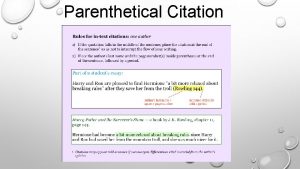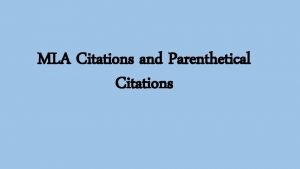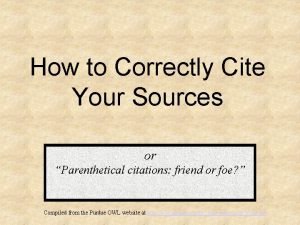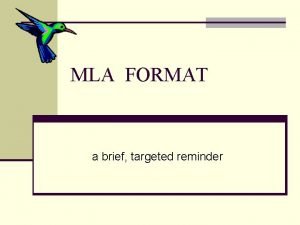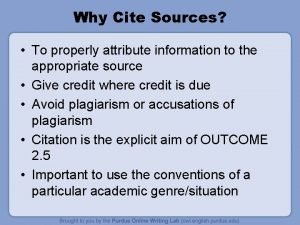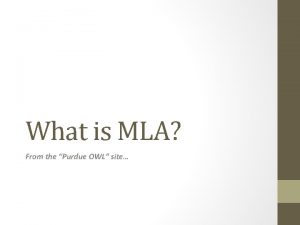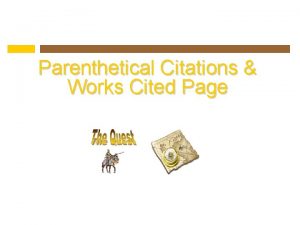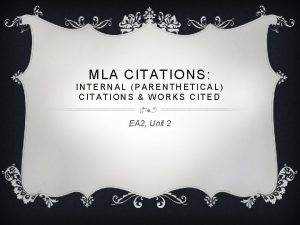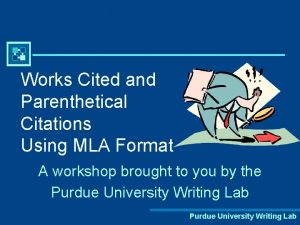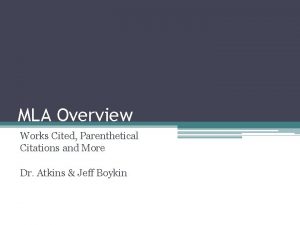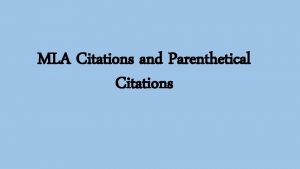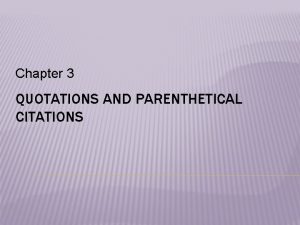Works Cited Parenthetical Citations and Plagiarism How Not















- Slides: 15

Works Cited, Parenthetical Citations, and Plagiarism How Not To Fail Your Research Paper

What Is Plagiarism? • When you write a research paper, you need to make sure you give credit to the sources you used to conduct your research and find your information. • Plagiarism is presenting information you got from another source as your own. • In order to give proper credit, MLA format REQUIRES you to have BOTH a Works Cited page and parenthetical (in-text) citations. • If you do not have both of these components, whether intentional or unintentional, you have plagiarized.

How To Write A Works Cited Page • Your Works Cited page must be written in MLA format. If you are not sure what that should look like, look back at the handout you received at the start of the research process. You can also look up MLA format online.

How To Write A Works Cited Page 1. Your Works Cited page must be a page by itself. It cannot have any other information on it. 2. At the top center of the page, title it Works Cited. 3. Each of your entries should be alphabetized by the first word in the entry. Entries should be single-spaced, with a double space between each different source.

Sample Works Cited Page Works Cited Doe, John. The Life of Henry VIII. Leesburg: LCHS Publishing, 2011. Print Henry VIII. English Research Organization. 3 February 2011. Web. 20 February 2011. Smith, Jane. “Kings of England”. History Reference Center 4. 1 (2009): 15 -30. Web. 20 February 2011.

Parenthetical (a. k. a. In-Text) Citations • In addition to a Works Cited page, which gives the full bibliographic information for your sources, you must also include parenthetical (sometimes called in-text) citations as well. • These parenthetical citations are like a shortened version of your full source citation. They let the reader know which source in your works cited that piece of information comes from. • You need to cite after EVERY piece of information you took from another source, whether you directly quote it or you paraphrase it!!!!! If you have it on a note card, and you put it in your paper, you must cite it!!!!

Tips For Writing Parenthetical Citations • Your parenthetical citations come after the sentence that your are quoting or paraphrasing, after any quotation marks, before the end punctuation. • For book sources, include the author’s last name and the page number in parenthesis. Ex: “”(Doe 115). • If the work does not have an author, use the title of the website/article instead. Ex: “”(“Henry VIII”)

Sample Parenthetical Citations King Henry VIII was a “Tudor king who ruled during the 16 th century” (Doe 154). He is most famous for his many marriages and split with the Catholic Church (“Henry VIII”). “Henry VIII was the father of Queen Elizabeth, one of England’s greatest rulers” (Smith). In his book, John Doe states that Henry VIII “was largely influential in shaping the England we know today” (156).

Quoting vs. Paraphrasing • Quoting means you write down the information from a source word for word. When quoting a source you must enclose the portion of the text in quotation marks as well as supply an in-text citation. • Paraphrasing means you put the information from the source in your own words. You need to supply an in-text citation for paraphrased information as well.

How to Paraphrase Properly • Look at your notes or the passage a few times, and then look away as you write your paraphrase. This will make it less likely that you will simply change a few words, and more likely that you will truly be putting the passage into your own words. • Put any key words or phrases that appear word-forword from the original text in quotation marks. • Give an in-text citation for the information in proper MLA format.

A Few Tips for Quotations • Make sure you use quotation marks to mark the beginning and the end of the quotation. • Integrate your quotes into your writing, either by signaling to your reader that a quote is coming or by explaining how the quote relates to the topic of your paragraph. Don’t just drop and quotation into your paragraph without an explanation. • Punctuation should come after the parenthetical citation. Question marks or exclamation points that are part of the quotation should come within the quotation marks.

Proper Format for Long Quotations • Long quotations (more than four lines) should be written as a block of text. Indent the entire quote, and do not include quotation marks. The in-text citation should come after the final punctuation.

Sample Long Quotation In his book on Henry VIII, John Doe states, Henry VIII was a very influential monarch. His decision to split with the Catholic Church changed the face of England forever. Despite this major religious and political change, he is still remembered mainly for his many wives. (Doe 67)

One more piece of advice… If you are writing a paragraph, and you have several sentences of information that need to be cited, but they all come from the same source, you may put your citation at the end of that chunk of information, as opposed to after every sentence. In order to do this, you must make sure that the information is all clumped together, and that it all comes from the same exact source. Once you introduce information from a new source, you must start citing after each piece of information.

An example Henry VIII was one of the Tudor kings of England. He ruled during the 16 th century and “was known for his many wives”. During his reign England experienced much upheaval and turmoil. (Doe 117 -123). Henry was terrified of civil war, and so was obsessed with having a male heir to leave his throne (Smith).
 What is a parenthetical citation
What is a parenthetical citation Parenthetical citations
Parenthetical citations What is a parenthetical citation
What is a parenthetical citation How to cite an image
How to cite an image How to punctuate parenthetical citations
How to punctuate parenthetical citations Works cited for romeo and juliet
Works cited for romeo and juliet What is a work cited page
What is a work cited page Citation purpose
Citation purpose Mla works cited website no author
Mla works cited website no author In text citation example
In text citation example Purdue owl mla
Purdue owl mla Bibliography vs works cited
Bibliography vs works cited How to do a work cited
How to do a work cited Mla works cited alphabetical order
Mla works cited alphabetical order Proper works cited
Proper works cited Works cited examples
Works cited examples
